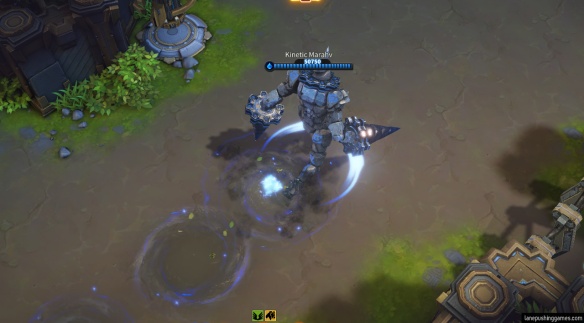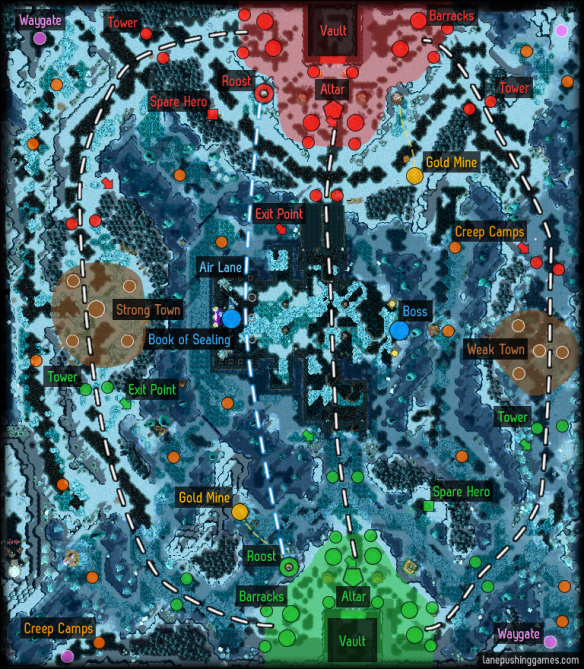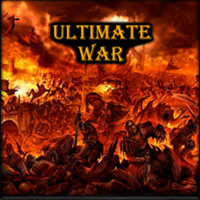 Jack of all trades and master of few, Master X Master (NCSoft, 2016-2018) is a playfully presented game with lots of modes, features, and character customisation options to tinker with.
Jack of all trades and master of few, Master X Master (NCSoft, 2016-2018) is a playfully presented game with lots of modes, features, and character customisation options to tinker with.
Among its many modes is a 5v5 lane-pushing battle called Titan Ruins, which will be the main focus of this review. The game has been announced to close for the last time on 31st January 2018, so if you haven’t taken it for a spin yet, head on over to the official site and give it a spin. It looks like there’ll be a closing tournament to see the game off as well.

Heroes
The most distinctive trait of Master X Master is that players select two masters at the start of the game. These are played as a tag-team pair: only one will be active on the battlefield at any time. One of your masters is visible to the enemy team when you pick, and the other is concealed until picking heroes has concluded.
Masters have the following abilities:
- A basic attack, which is always aimed.
- A passive, offering some twist on how the hero should optimally attack or cast. Typical examples are “every third cast you get a shield”, or “incoming crowd control is reduced by 25%”.
- An escape, which can be a dash, stasis, speed boost, and sometimes will have offensive potential.
- A spell, which is picked pre-game from a small selection. Both your masters will share one spell.
- Four traits, stats which can be upgraded gradually during a match.
- Four basic skills, of which a player can bring any two into a match.
- An ultimate, which requires ultimate meter to cast.

The traits for a player’s masters.
This game uses WASD movement, so basic attacks are always aimed towards your cursor. They come in lots of varieties, including cleaving, double-attack, optional charge up, attacks which heal allies, split on impact, long-ranged missiles, goops of acid that stay on the ground, and ranged attacks which deal less damage at short range. Most weapons will overheat after a few seconds of continuous use.
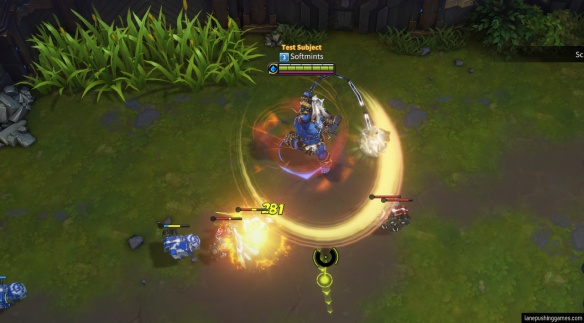
Cagnazzo swings his ball in an arc, damaging everything it hits.
Masters can move and strafe constantly without penalty, so that is exactly what they do at all times. It can be difficult to keep bullets trained on a target if you’re not used to it!
It’s possible to walk up ramps, jump, and shoot down from cliffs, which is fun but the game stays firmly 2.5D.
Basic skills are unusual in that players must choose pre-game for both of their heroes, which skills they will bring into a match. There is also total freedom to decide which will be your Q or your E for each master. That’s important, because masters get skill points as they level up, and the Q on both heroes will take points simultaneously.
Skill points offer a different sort of value to most lane-pushing games. They apply to basic skills and ultimates only. They don’t linearly increase certain values of the skill; instead they offer a different flat bonus at each level. Usually levels 3 and 6 offer something juicy, and it’s allowed to sink six consecutive points into the same skill so that seems like the strictly optimal choice.
The available Spells are:
- Heal will restore health to nearby allies and buildings over 5 seconds.
- Shield a friendly tower or Titan for a short duration.
- Sprint to move faster for a few seconds.
- Ward grants vision in an area for several minutes.
- Teleport to a friendly tower or Watch Tower.
I appreciate that all of these are useful and a team might encounter difficulty deciding which to prioritise.
Affinities and Tagging
Every master belongs to one of the three Damage Affinities. These are Argent, Helix, and Kinetic.
It is a simple rock-paper-scissors system, where each affinity deals +15% and takes -15% damage from one of the others. That is a 30% relative dps advantage for an affinity advantage in an engagement! Damage from the same affinity has no modifier.

It would be pretty awful to arrive at a lane matchup and be at a natural disadvantage like this. Thankfully, that’s what the tag-team system is for! As long as a player pick two masters with different affinities, any 1v1 is guaranteed at least an even match.
Each of your masters has a separate health and mana pool, as well as its own ability cooldowns. Ultimate meter is shared, as is the cooldown of the spell. The Tag ability is used to instantly switch which master is active. This has a 14-second cooldown.
There are two things in the above paragraph that I strongly disagree with. In perSonas (the game which first introduced tag-team to mobas in 2006), health and mana pools were shared, and the switch cooldown was 6 seconds. That worked. You switched often because you could, it was offensively good to unload more spells, and there was nothing to lose defensively.
MXM’s numbers mean that switching to unload more spells gives up access to your precious extra health pool for 14 seconds. That’s a really bad idea, and players know it. You really shouldn’t switch unless your current health pool is not going to be useful to you: either because it took too much damage already, or you won’t see combat for 10+ seconds.
I don’t see why MXM went its own way here. perSonas already got this right.
Lanes and Titans
Following some familiar patterns, there are three lanes and a couple of towers protecting them. Only the mid lane has outer towers, and there are no barracks or similar objectives inside the bases.
During gameplay, teams collect Points through almost everything they do: with last hits awarding 1 point each, and clearing the jungle, hero kills, and so on more. Points are an important factor towards winning, and will directly grant victory if you reach 1000, or the game lasts 25 minutes without a core being destroyed. (The team with higher points in that scenario wins.)
Every 100 points collected by a team will cause a friendly Titan to spawn and march down the mid lane. These powerful troops are tanky and good at hurting everything, particularly enemy towers and their core.
There are three types of Titan that can spawn: one for each damage affinity. They have separate strengths and abilities, and of course are resistant or vulnerable to masters based on how the affinities match up.
Here’s the breakdown:
 Argent:
Argent:
- Globally, allied masters gain 20% lifesteal and increased stamina regeneration.
- Each nearby friendly master increases its damage by 20%.
- It will sometimes fire a damaging shockwave at enemies.
- On death, it explodes to hurt nearby enemies.
 Helix:
Helix:
- Globally, allied masters gain armour, magic armour, and increased health regeneration.
- Blocks incoming projectiles from its facing direction with its massive shield.
- It can heal all allies in a large area.
- On death, any nearby allies are shielded.
 Kinetic:
Kinetic:
- Globally, allied masters gain cooldown reduction and increased mana regeneration.
- Leaves behind a trail that boosts the speed of friendly units and slows enemies.
- It will sometimes pull all nearby enemies to itself.
- The same will happen when it dies, with the addition of a heavy slow.
Titans are worth less experience to the enemy team the more they have travelled. Also, when one Titan kills another, it recovers about a third of its health. This avoids stalemate situations where Titans keep cancelling each other out.
The first Titan to spawn each game has two properties:
- Its type will be random. All Titans thereafter will follow the sequence Argent, Helix, Kinetic, Argent…
- It will appear with a substantial amount of shields, as a perk for the team being the first to 100 points.
I’m not a fan of the random/uncontrollable Titan types. If this system allowed player interaction, then maybe players could think about which Titan they wanted and the differences between Titans would be something to celebrate. In their current state, there is not much to be done other than get points and Titans as quick as you can.
Monolith and Shards
Among the various ‘unfriendlies’ to be found off-lane is the Titan Monolith, a strange turret device that can only be attacked from short range. Like all the unfriendlies, it uses pattern attacks which are usually marked with red areas to allow a moment to dodge.
When the Monolith or a Titan dies, they drop a Titan Shard. These behave a little like a “capture the flag” objective. Walking over a Shard will pick it up, revealing that master to both teams for a brief moment. It slows the master carrying it, and bringing it back to the safety of the main base will secure it for your team.
Once five Shards have been assembled, anyone on the team can temporarily transform their master into a Titan Incarnate. This is a better version of the Titans above: packing tons of health and damage, and having the advantages of being deployable anywhere, and being able to focus enemy masters or buildings as the situation requires.
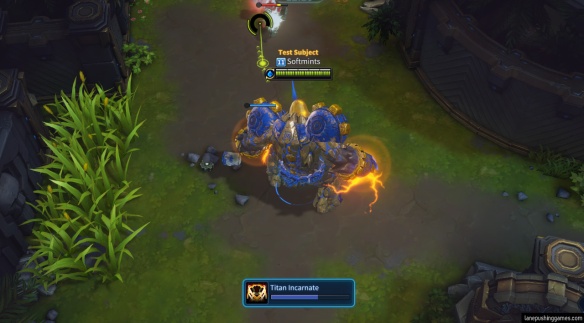
In fact, Titan Incarnate has two forms: a “brawling” one (active by default) which has huge line damage and can leap, and a “hammer” form which excels at hurting buildings and can shield all nearby allies and itself.
The Incarnate’s basic attack has a pattern: its third attack sends out a shockwave, while in hammer form it uses a fast weaker swing followed by a strong heavy one. It takes a bit of practice to learn to use these special forms.
The transformation takes a couple of seconds, during which any two players can veto it, or any two players can okay it (in which case the transformation completes instantly). This feels like a sensible way to let the team contribute on when precious shards get used, and allowing ‘yes’ votes to accelerate the transformation means voting yes has tangible value: encouraging players to do it whenever appropriate.
An important note is that the Incarnate will adopt the affinity of whichever master did the transformation. That is really important when you’re outputting the kind of damage that an Incarnate does (or taking the kind of focus-fire as well!)
Buffs and Bosses
Four Watch Towers are placed on hills around the map. They take a short channel to claim, and grant vision for 5 straight minutes thereafter (during which the enemy team can’t contest them). Since matches last at most 25 minutes, taking a watch tower secures its vision and value as a Teleport target (for the Spell that all players can take) for at least 20% of the game.
The jungle contains some buff camps: two red, two blue. Both colours provide identical bonuses (reduced tag cooldown, and health/mana/stamina regeneration), which would be redundant except that the blue and red buffs stack with each other. Together they’re a considerable powerup. (Getting two blues would simply refresh the duration.)
The weak boss on the map is King Tanian, who grants 30 points and some experience when defeated.

The King’s Cross. One of many delights he has to throw at us.
Opposite him on the map is Rozark, the biggest objective. He lives inside an underground chamber. To enter, masters must briefly channel without taking damage to enter. Leaving a hero on lookout seems like a handy way to take him with minimal interruption, especially if the nearby Watch Tower has been claimed.
Rozark awards an immediate 100 points, and places a curse on enemy towers when defeated.

Busy being a pattern boss and whatnot.
In the corners of the map are two Fallen Altars, which are protected by a pair of guardians. It’s possible to defeat the guardians without taking any damage since they signal their dashes and swipes with enough time to dodge. As previously mentioned: this is true for all the unfriendlies, but it matters more for an on-lane objective where having to tank damage would be unfavourable for laning. Instead, we have a situation where the objective is tricky only when enemy players show up.
Once slain, a modest channel will capture the Altar, freeing a Fallen Hero to push that lane for your team. Usually the enemy will try to interrupt with an attack or two, so finishing the channel isn’t always easy. Especially not late-game, when its duration reaches 15+ seconds…
The Fallen Hero is a great pushing companion, who will pick a nearby ally to link with, steadily healing them and granting damage reduction. Very handy! Occasionally it will also try to hook enemy masters to itself, use cone attacks and so on.
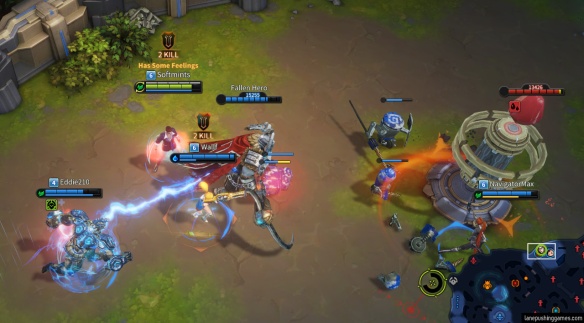
Fallen, but won’t allow others to fall so easily!
Even towers get in on the “action” style of the game: they will occasionally release a burst that knocks enemies away from them if they take enough damage. It keeps pushing interesting I guess, if the various super troops weren’t enough to do most of the job.
In the middle of the map, there are two bodies of water each housing a River King. This little fishey is available to hunt from the start of the match, and grants some healing and ultimate meter when killed. It is almost harmless to fight, unlike everything else.
Client and Atmosphere
It’s worth noting that MXM is not just a lane-pushing game. It has lots of short co-op stages which can be cleared, many of which are nicely decorated and have fun enemies. It has a 3v3 arena mode, and a 4v4 capture-points mode as well. You use the same masters and swapping mechanic for all of these.
The client itself is themed as the hull of a spaceship, and your character actually stands there and can walk around/emote/chat with other users while you wait between games. There’s even a jukebox where you can put on music for everyone else to listen to. Pro tip: always choose this track.
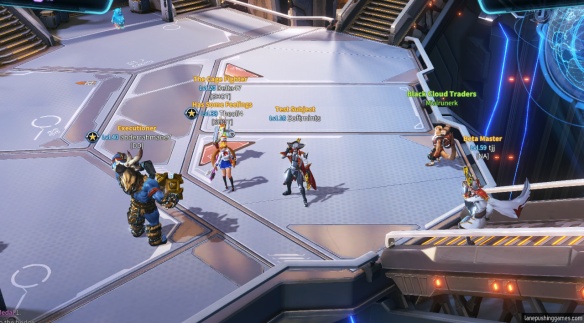
Hanging around: in space! This used to be packed in early alpha.
The music is upbeat and fun, and the heroes are a mixture of everything: stone beasts that look like they’d fit right in with the Titans, blobs of orange goop, baseball players and boxers, idol singers… there’s something (or a skin) for everyone.
Frankly, a lot of effort went into this game (certainly for the western market), and it’s not entirely clear why it’s closing down. My suspicion is that something went awry in NCSoft’s home market of South Korea, and resources were moved elsewhere. If so, that sucks because MXM is an entertaining game.
Stat Padding
Among the many, many things you can spend your time collecting or crafting in the client, are Nodes, which are functionally similar to League’s former masteries. There are six nodes to a page, and you bring one page into any match that you play in, to be shared by both your masters.
The nodes are split between offensive/defensive/utility, and offer effects like +10% crit chance, +3% movespeed, +27% tagged-out regeneration, +5% weapon damage, +8.7% cooldown reduction, and so on.
Combined, a node page could offer +30% weapon damage(!) if you had six of the good ones. However, this is slightly dampened because each master has a “preference” for which node types it wants. Vonak wants three offensive, one defensive, and two utility (3/1/2). Lilu wants (1/1/4). If you use more of a colour than the master’s preference, nodes of that colour will have reduced efficiency.
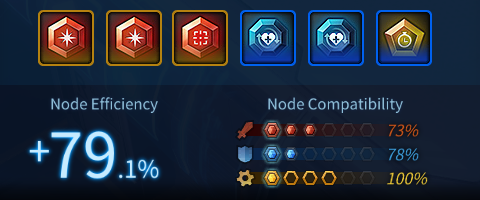
Here, my extra offensive and defensive nodes are at reduced efficiency. The large number displays overall efficiency.
For further customisation goodness, every master’s basic attack has three upgrade paths which can be pursued as well (requiring assorted junk to actually do the upgrades). The paths include bonus range, damage, splash angle, projectile speed, charge time (for masters with a charged up attack), healing, reducing heat buildup, and more.
Closing Thoughts
I enjoyed messing around in MXM, but three things made it hard to enjoy the game.
Firstly, WASD movement is a nice change of pace, but I still have some reservations about how MXM handles it. Masters suffer no movement penalty when they attack, so kiting around is automatic behaviour for everyone all of the time. It feels very thoughtless.
Secondly, the game has a min-maxer attitude underlying it. The combination of nodes, attack upgrades, the unusual skill point stats, traits, and damage affinities means there is always a percent or two to be improved upon somewhere if you put your mind to it.
There is a point where adding more knobs and whistles to the definition of a hero is too much. MXM sails right past that. If all the passive complications weren’t enough, masters don’t even consistently have the same skills: their basics and their attack could be different depending on what was picked.
This is while there are five pairs of enemy heroes on the enemy team to keep track of in each match. There are too many little things adding up, and not enough big things that mean something.
Finally, if we consider the “hook” of MXM to be playing as two heroes and switching back and forth between them, two critical design choices (separate health pools and Tag’s lengthy cooldown) are poisonous. They encourage playing like a single-hero moba as much as possible, where sometimes you have a free health refill.
I expected that the promise of MXM would be the same as the promise of perSonas: that I would get to be swapping back and forth mid-combat doing clever things. This iteration of MXM seems to be for someone different: someone who doesn’t really know what they want but it definitely involves practising lots of small tweaks and procedures.
Differences in culture, or target audience, perhaps? I don’t know, but more could have been done with these ideas. Maybe someday under a new Master.
